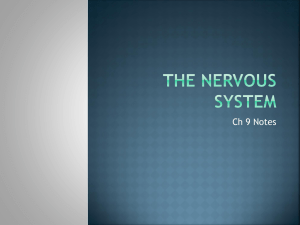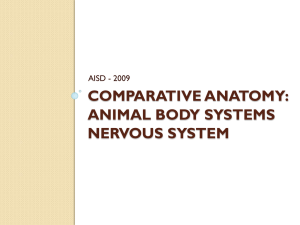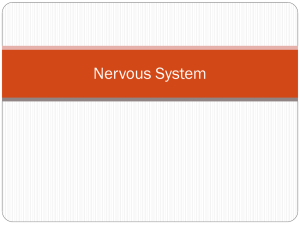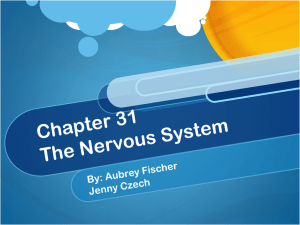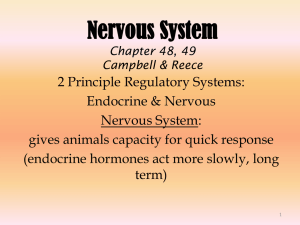PPT10Chapter10TheNervousSystem
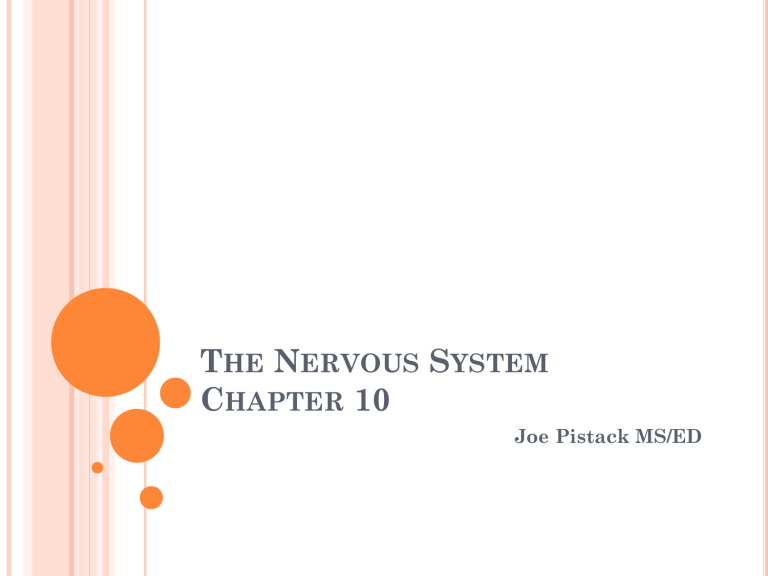
T HE N ERVOUS S YSTEM
C HAPTER 10
Joe Pistack MS/ED
S TRUCTURE AND F UNCTION
Nervous System-acts as an interpreter for the various organ systems.
Coordinates and directs the activity of the nervous system.
Acts as a “conductor” for the nervous system, so that the functions are perfomed correctly.
D IVISIONS OF THE N ERVOUS S YSTEM
Central Nervous System
(CNS)-includes:
Peripheral Nervous
System
(PNS)-includes:
The brain
Nerves that connect the CNS with the rest of the body.
The Spinal cord
The brain is located in the cranium and the spinal cord is enclosed in the spinal cavity.
The peripheral nervous system is located outside the
CNS.
D IVISIONS OF THE C ENTRAL N ORVOUS
S YSTEM
F UNCTIONS OF THE N ERVOUS S YSTEM
The nervous system performs three general functions:
(1)-Sensory function
(2)-Integrative function
(3)-Motor function
S ENSORY F UNCTION
The nerves gather information from inside the body and from the outside environment.
The nerves then carry the information to the
CNS.
Ex. You come in contact with a cat, you see the cat and the information is picked up by the special senses in the eye. The brain recalls how a cat should act.
I NTEGRATIVE F UNCTION
Sensory information brought to the CNS is processed or interpreted.
The brain recalls the information.
The brain integrates or puts together everything it knows about the subject and then makes a plan.
Ex. The brain recalls the information about how a cat is to react and puts it together.
M OTOR F UNCTION
The motor nerves convey information from the
CNS toward the muscle and glands of the body.
The motor nerves carry out the plan made by the
CNS.
The motor nerve converts the plan into action.
Ex. Person may decide that the cat needs to eat, information travels along the motor nerves from the CNS to the skeletal muscles needed so that you have the movement to feed the cat.
F UNCTIONS OF THE N ERVOUS S YSTEM
N EUROGLIA
Neuroglia or glial cells:
The nerve glue, holds the cell together.
Most glial cells are located in the CNS.
They support, insulate, nourish and care for delicate neurons.
Some participate in phagocytosis, others assist in the secretion of cerebrospinal fluid.
N EUROGLIA
Do not conduct electrical impulses.
Astrocytes- most abundant glial cell.
Supports the neurons and forms a protective barrier around the neurons of the
CNS.
Barrier helps to prevent toxic substances in the blood stream from entering the nervous tissue of the brain and the spinal cord.
N EURON
Second type of nerve cell.
Most important in the transmission of information.
Enables the nervous system to act as a vast communication network.
Have many shapes and sizes.
Nonmitotic, do not replicate when injured.
P ARTS OF A NEURON
Parts of a neuron:
(1) Dendrites
(2) Cell Body
(3) Axon
(4) Axon Terminals
P ARTS OF A N EURON
Axon-a long extension that transmits information away from the cell body.
The end of the axon undergoes extensive branching to form hundreds of thousands of axon terminals, this is where chemical neurotransmitters are stored.
P ARTS OF A NEURON
Myelin sheath-layer of white fatty material that encases most of the nerve fibers of the peripheral and central nervous system.
Myelin-protects and insulates the axon.
Myelinated-when nerve fibers are covered with myelin.
Unmyelinated-neurons that are not encased in myelin .
T YPES OF N EURONS
Three types of neurons:
(1) Sensory neuron-carries information from the periphery toward the CNS. Also called, afferent neurons.
(2) Motor neuron-carries information from the CNS toward the periphery. Also called efferent neurons.
(3) Interneuron-found only in the CNS. Form connections between sensory and motor neurons. In the brain, they play a role in thinking, learning and memory.
W HITE MATTER AND GRAY MATTER
The tissue of the CNS is white and gray.
White matter is white because of the myelin.
Myelinated fibers are gathered together in the
CNS tracts.
The gray matter is composed primarily of cell bodies, interneurons, and unmyelinated fibers.
W HITE MATTER VERSUS GRAY MATTER
Nuclei-clusters of cell bodies located in the CNS.
Ganglia-(singular-ganglion)-small clusters of cell bodies located in the CNS.
Basal nuclei-patches of gray, located in the brain.
N ERVE I MPULSES
Neurons allow the nervous system to rapidly convey information from one body part to the next. Ex. Stubbed toe.
Information is carried along the neuron in the form of a nerve impulse.
Nerve Impulse-an electrical signal that conveys information along a neuron.
N ERVE I MPULSE
Action potential-a process of polarization, depolarization, and repolarization.
Polarization-the resting state of a neuron. No nerve impulse is being transmitted. The cell is quiet.
Depolarization-the neuron is stimulated, a change occurs in the cell’s electrical state.
Repolarization-cell returning to its resting place. Unless the cell repolarizes, it cannot be stimulated again.
Refractory Period-the cell’s unresponsive period.
The phases of the nerve impulse are caused by the movement of ions, particularly Na+ and K+.
N ERVE I MPULSE
N ERVE IMPULSE
Axons of most fibers are wrapped in myelin.
At the nodes of
Ranvier, the axonal membrane is bare, not covered with myelin.
The nerve impulse arrives at the axon, it cannot develop on any part that is covered with myelin.
N ERVE I MPULSE
To convey information, a nerve impulse must move the length of the neuron, from the cell body to the axon terminal.
N ERVE I MPULSE
The nerve impulse will jump from node to node to the end of the axon.
Jumping from node to node is called saltatory conduction.
Saltatory conduction increases the speed with which the nerve impulse travels.
E VENTS OF A SYNAPSE
Many axons are myelinated to increase the speed of the nerve impulse.
The nerve impulse travels along the neuron from the dendrite to the end of the axon.
The impulse stimulates the release of neurotransmitters into the synaptic cleft.
The transmitter diffuses across the synaptic cleft, binds to the receptor and stimulates the dendrite of the second neuron.
T HE B RAIN
The brain is located in the cranial cavity.
Pinkish-gray, delicate structure with a soft consistency.
The surface of the brain appears bumpy, like a walnut.
Weighs about 3lb.
T HE B RAIN
Primary source of energy for the brain is glucose.
Low blood glucose levels result in hypoglycemia.
S/S patient will exhibit are: mental confusion, dizziness, convulsions, loss of consciousness, death.
T HE B RAIN
T HE B RAIN
The brain is divided into four major areas:
The Cerebrum
The Diencephalon
The Brain Stem
The Cerebellum
T HE C EREBRUM
The cerebrum contains both gray and white matter.
Cerebral Cortex-thin layer of gray matter that forms the outermost portion of the cerebrum.
The gray matter of the cerebral cortex allows us to perform higher mental tasks such as learning, reasoning, language, and memory.
The bulk of the cerebrum is composed of white matter located directly below the cortex.
T HE C EREBRUM
The bumps of the cerebrum have several markings, or structures with special names.
The surface of the cerebrum is folded into elevations called convolutions or gyri.
T HE C EREBRUM
The extensive folding increases the amount of the cerebral cortex.
It is thought that intelligence is related to the amount of cerebral cortex.
Sulci-the grooves that separate the gyri.
L OBES OF THE C EREBRUM
Frontal Lobe- located in the front of the cranium under the frontal bone.
Plays a key role in voluntary motor function, personality, behavior, emotional expression, intellectual functions, and memory storage. Also involved with thinking learning and making plans. These are called
“executive functions”
F RONTAL L OBE
Broca’s area-the part of the frontal lobe concerned with speech.
In most people it is in the left hemisphere.
(some people it is in the right hemisphere).
If damaged, (CVA) the person develops aphasia – the person knows what they want to say but can’t
F RONTAL L OBE
Frontal eye fieldlocated above Broca’s area.
Controls voluntary movements of the eyes and the eyelids.
Ex. Ability to scan a paragraph.
D ECUSSATION
Decussation-the crossing over of nerve fibers from one side of the brain to the other side of the body.
Fibers leave the motor area of the left frontal lobe cross over, and innervate the right side of the body.
The fibers from the right frontal lobe also cross over and innervate the left side of the body.
Ex. Damage to the left side of the brain causes paralysis to the right side of the body.
P ARIETAL L OBE
Located behind the central sulcus.
Primarily concerned with receiving general sensory information from the body.
Called the primary somatosensory area because it receives sensations from the body.
P ARIETAL L OBE
The primary somatosensory area- receives information from the skin and muscles and allows you to experience the sensations of temperature, pain, light touch, and proprioception, (a sense of where your body is).
The parietal lobe is also concerned with reading, speech and taste.
T EMPORAL L OBE
Located inferior to the lateral fissure in the area above the ear.
Contains the primary auditory cortex, the area that allows you to hear.
Receives sensory information from the ears.
Damage to the temporal lobe causes deafness.
T EMPORAL L OBE
Olfactory area-receives sensory information from the nose. Area that controls smell.
Sensory information from the taste buds- are located in the tongue. Interpreted in both the temporal and parietal lobes.
Wernicke’s area-broad region located in both parietal and temporal lobes; concerned with the translation of thoughts into words.
Damage to this area can cause deficits in language comprehension.
T EMPORAL L OBE
O CCIPITAL LOBE
Located in the back of the head, underlying the occipital bone.
Contains the visual cortex.
Sensory fibers from the eye send information to the visual cortex of the occipital lobe, where it is interpreted as sight.
O CCIPITAL L OBE
Concerned with visual reflexes and vision-related functions such as reading.
Damage to the occipital lobe causes blindness.
A SSOCIATION AREAS
Large areas of the cerebral cortex that are concerned primarily with analyzing, interpreting and integrating information from the ear.
P ATCHES OF GRAY
Basal Nuclei-gray matter scattered throughout the cerebral white matter.
Help to regulate body movement and facial expression.
Dopamine is largely responsible for the activity of the basal nuclei.
A deficiency in dopamine within the basal nuclei is called Parkinson’s Disease.
P ARKINSON ’ S D ISEASE
Characterized by:
A shuffling and uncoordinated gait.
Rigidity
Slowness of speech.
Drooling.
Masklike facial expression.
Usually treated with dopamine or dopamine-like drugs.
D IENCEPHALON
Second main area of the brain.
Located beneath the cerebrum above the brain stem.
Includes the thalamus and the hypothalamus.
T HALAMUS
Serves as a relay station for most of the sensory fibers traveling from the lower brain and spinal cord region to the sensory areas of the cerebrum.
The thalamus sorts out the sensory information, gives us a hint of the sensation we are to experience, and then directs the information to the specific cerebral areas for more precise interpretation.
T HALAMUS
H YPOTHALAMUS
Second structure in the diencephalon.
Situated below the thalamus.
Regulates body temperature, water balance, and metabolism.
B RAIN S TEM
Connects the spinal cord with higher brain structures.
Composed of the midbrain, pons and medulla oblongata.
The white matter of the brain stem includes tracts that relay both sensory and motor information.
M IDBRAIN
Extends from the lower diencephalon to the pons.
Relays sensory and motor information.
Contains nuclei that function as reflex centers for vision and hearing.
P ONS
Extends from the midbrain to the medulla oblongata.
Plays a role in regulation of breathing rate and rhythm.
M EDULLA O BLONGATA
Connects the spinal cord with the pons.
Act as a relay for sensory and motor information.
Often called the vital center, controls heart rate, BP, and resp.
M EDULLA O BLONGATA
Extremely sensitive to certain drugs, especially narcotics.
Overdose causes depression of the medulla oblongata resulting in death if the patient stops breathing.
Always assess the respiratory rate before administering a narcotic, if less than 10 do not administer.
M EDULLA O BLONGATA
Also contains the vomiting center.
Vomiting center can be activated directly or indirectly.
Direct activation includes stimuli from the cerebral cortex such as fear, distressing sights, bad odors, pain or spinning sensation from the equilibrium apparatus of the inner ear.
M EDULLA O BLONGATA
Indirect stimulation of the vomiting center comes from the chemoreceptor trigger zone.
The (CTZ) can be stimulated by anticancer drugs, and narcotics.
Signals in the digestive tract may send signals to the vagus nerve to the (CTZ), this in turn may activate the vomiting center.
Antiemetic agents can work on the (CTZ) and the vomiting center to relieve nausea and vomiting.
C EREBELLUM
Fourth major area.
Protrudes from under the occipital lobe at the base of the skull.
Concerned primarily with coordination of voluntary muscle activity.
C EREBELLUM
Information is sent to the cerebellum from many areas throughout the body.
The cerebellum integrates all of the incoming information to produce a smooth, coordinated, muscle response.
Damage to the cerebellum produces jerky muscle movements, staggering gait, and difficulty maintaining balance or equilibrium.
C EREBELLUM
The person with cerebellar dysfunction may appear intoxicated.
Diagnose cerebellar dysfunction-have the patient touch the tip of the nose with finger.
The cerebellum normally coordinates muscle activity, a patient with cerebellar dysfunction may overshoot , first to one side and then the other.
S TRUCTURES THAT OVERLAP
Limbic system:
Made up of parts of the cerebrum and the diencephalon, form a wishbone-shaped structure.
Called the emotional brain-functions in emotional states and behavior.
R ETICULAR F ORMATION
Special mass of gray matter.
Extends through the entire brain stem.
Concerned with the sleep-wake cycle and consciousness.
R ETICULAR F ORMATION
Signals passing up to the cerebral cortex from the reticular formation stimulate us, keeping us awake.
This area is sensitive to tranquilizers and alcohol, can cause damage to the reticular formation causing permanent unconsciousness.
C ONSCIOUSNESS
Consciousness-state of wakefulness. Depends on our reticular activating system (RAS).
The RAS is continuously receiving information from all over the body, it will send any unusual signals to the cerebral cortex for interpretation.
Different levels of consciousness:
Attentiveness
Alertness
Relaxation
Inattentiveness
S LEEP
Sleep- occurs when the reticular activating system is inhibited or slowed.
Coma-sleeplike state with several stages, ranging from light to deep.
Light stages- some reflexes are intact, patient may respond to light, sound, touch, or painful stimuli.
As coma deepens the patient gradually becomes unresponsive to all stimuli.
S TAGES OF SLEEP
Two types of sleep:
1. Non-Rapid Eye Movements (NREM) sleep.
2. Rapid Eye Movement (REM) sleep.
Four stages of NREM sleep progress from light to deep.
In a typical 8-hour sleep period a person cycles through various stages of sleep from light to deep and deep to light.
REM sleep is characterized by fluctuating blood pressure, resp. rate and rhythm and pulse rate.
S LEEP
REM sleep is characterized by rapid eye movements.
Most dreaming occurs during REM sleep .
Deprivation of REM sleep is is associated with mental and physical distress.
M EMORY
Ability to recall thoughts and images.
Areas of the brain concerned with memory:
Frontal
Parietal
Occipital
Temporal lobes
Limbic system
Diencephalon
M EMORY
Two categories:
1. Short-term-lasts for short periods of time,
(seconds to a few hours).Allows you to recall such things as prices or telephone numbers.
Cramming for tests!
2. Long-term-lasts years or decades. Learned over a longer period of time.
P ROTECTION OF THE C ENTRAL N ERVOUS
S YSTEM
Tissue of the brain and spinal cord are very delicate.
Has an elaborate protective system that consists of four structures:
1. Bone
2. Meninges
3. Cerebrospinal fluid
4. Blood-brain barrier
F IRST LAYER OF PROTECTION
First layer is bone, the brain is encased in the cranium while the spinal cord is encased in the vertebral column.
L AYERS OF P ROTECTION
Meninges-three layers of connective tissue that surround the brain and the spinal cord.
Dura mater-the outermost layer of the thick, tough, connective tissue. (Meaning “hard mother”)
Arachnoid- (spiderlike). Middle layer, forms a web for protection.
L AYERS OF PROTECTION
Pia mater-innermost layer, soft. (Meaning “gentle mother”).
Pia mater is a very thin membrane and contains blood vessels and lies delicately over the brain and spinal cord. Blood vessels supply the brain with much of it’s blood.
Subarachnoid space-lies between the arachnoid space and the pia mater. Cerebrospinal fluid circulates within this space.
L AYERS OF PROTECTION
Cerebrospinal fluid circulates around the brain and forms a cushion.
Ex. Protects if the brain is jarred.
Arachnoid villi-projections of the arachnoid membrane that protrude up into the blood filled dural spaces.
Brain Pad P-pia mater
A-arachnoid
D-dura mater
T HREE LAYERS OF THE MENINGES
M ENINGITIS
Meningitis-inflammation of the meninges.
Serious infection that may spread to the brain.
Diagnosis by testing the cerebrospinal fluid obtained by lumbar puncture.
C EREBROSPINAL FLUID
Formed in the Choroid Plexus
Third layer of protection:
Formed from the blood within the brain.
CSF is a clear fluid, consistency of plasma.
Composed of water, glucose, protein, and several ions.
.
Adult circulates about 500ml every 24 hours.
C EREBROSPINAL F LUID
Formed in the choroid plexus in the ventricles of the brain.
Choroid plexus is a grapelike collection of blood vessels and ependymal cells.
The rate at which CSF is formed must equal the rate at which it is drained.
If drainage is impaired, CSF will accumulate in the ventricles of the brain, increasing pressure within the skull, may result in brain damage or death if not treated.
B LOOD -B RAIN B ARRIER
Fourth layer of protection:
Arrangement of cells, particularly glial astrocytes.
Cells select the substances allowed to enter the
CNS from the blood.
The blood-brain barrier is successful in screening many harmful substances, but not all toxic substances are blocked.
Ex. Alcohol can cross the blood-brain barrier and affect brain tissue.
B LOOD BRAIN BARRIER
Most antibiotics cannot cross the blood-brain barrier and therefore cannot reach the site of infections within the CNS.
May need to inject antibiotic directly into the subarachnoid space.


